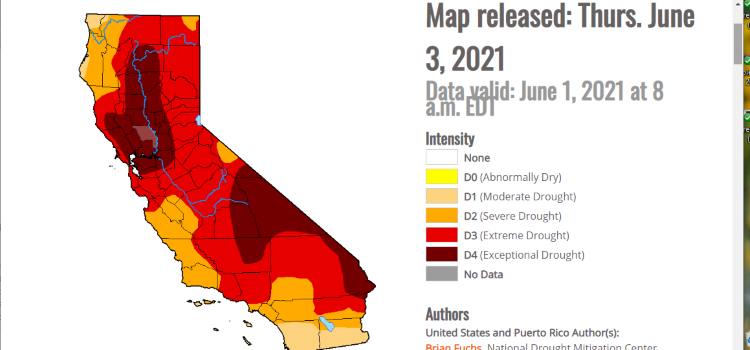As California’s statewide drought worsens, Santa Clara County's water district may declare a water shortage emergency and urge the county to do the same.
Valley Water, the Santa Clara Valley Water District, is to consider declaring emergency status, and implementing a recommendation for 15 percent water reduction for all county residents at its Wednesday meeting.
The water agency board’s action on June 9 would follow by a month a decision to raise water rates 9.1% for the fiscal year that begins next month.
The reason the water district is voting to encourage the county to declare a local state of emergency is because “a couple horrible things are happening all at this same time,” Valley Water Director Gary Kremen said in an interview..
The first is the reconstruction of the Anderson Dam, which forced the draining of the Anderson Reservoir, formerly the county’s biggest water storage facility, equal to all the other reservoirs in the county combined. Because of the dam reconstruction, the reservoir is at just 3 percent capacity, “so it’s 90% empty,” Kremen said.
He also said the county is having a hard time buying water on the open market because of the growing drought conditions statewide and low snow-melt totals this spring. Santa Clara County buys and imports about half of its water.
“Everyone else is buying it at the same time, so prices are about 10 times what they were two years ago,” Kremen said.
Drought conditions in California remain at record highs, with most of the state now classified in “extreme” or “exceptional” drought, according to a new report from the U.S. Drought Monitor. Much of the Bay Area north of San Jose last week was included in the most severe “exceptional drought” zone, along with much of southeast California, the report said. The entire Bay Area and around 74% of the state are at least in “extreme” conditions. In the Western U.S., that condition extends to about 53%.
On top of that, Santa Clara County has not received its typical water allocation from the state of California.
Kremen said the county only received 5 percent of its expected allocation from the state and nothing from the federal government’s water allocation for agriculture. In terms of water for municipal and industrial usage, the county was expecting 55 percent of its typical allocation, but that was recently cut to 25%, Kremen said.
Because Valley Water acts primarily as a wholesaler to local municipal water districts, it can recommend residents cut water usage by a certain percentage—which it has done almost every year in the last decade—but it has no legal authority to enforce restrictions.
Kremen said the water district has been working with cities and the county to come up with an enforcement strategy. He said Valley Water relies on incentives instead of punitive measures to encourage residents to comply with water cutbacks.
The incentives include rebates for grass removal, inspections of businesses and homes to find leaks or other water conservation solutions and other incentives listed on their website.
Kremen said that at this point, Valley Water isn’t asking residents to cut back on health and safety water usage like showers and cooking, but instead on nonessential water usages like landscaping.
“You know, water for bathing, water for cooking is around 50 gallons per person per day,” Kremen said. “No one’s asking anyone to go below that.”
Santa Clara County may be able to survive this summer with relatively healthy groundwater levels, but Kremen worries that without cutbacks, the county may be in an even more calamitous situation next year.
“Here's the analogy that I'd like you to think about,” Kremen said. “We're in a plane right now and the engines have stopped. Is it better to kind of declare an emergency when you’re at 24,000 feet—that's where we are, from our normal cruising altitude of 30,000 feet—or at 1,000 feet?”
The county’s groundwater levels are at 24,000 feet. Healthy non-drought levels would be 30,000.
“We can see where next year could be next year and we want to be sure there's something left in the groundwater, some carryover water for next year,” he said.
The Valley Water board will vote on a 15% reduction suggestion at their Wednesday meeting, but Kremen said it is up to the board to decide if that percentage should be higher or lower or not implemented at all.
The suggestion for 15% cutbacks came from the staff at Valley Water, who said without conservation efforts, the county could be in emergency drought situation (stage 5) by 2022, according to a recent water supply scenario report.
Even with conservation efforts, the county could still reach Stage 3, severe drought, of its water shortage contingency plan.
The county is at Stage 1, which is normal, but is close to Stage 2 which is considered an “alert stage.”
Kremen said he also hopes Gov. Gavin Newsom will declare that Santa Clara County is in a drought.
Santa Clara County's extreme drought condition means that not only is soil dry and pasture growth is stunted, but the county is threatened by wildfires year-round; water is inadequate for agriculture, wildlife, and urban needs; and reservoirs are extremely low.
If the governor declares a drought in the county that would help with creative financing and additional funding to create larger water conservation programs, Kremen said.
“No one has made the 15% decision, I know I haven’t,” Kremen said. “I need to hear what the public has to say”
The meeting will start at 1pm on Wednesday, June 9. Residents can access the meeting and make public comment at the virtual meeting via Zoom at https://valleywater.zoom.us/j/87957609335 or by calling 1 (669) 900-9128 (code: 87957609335#).


In spite of our looming water shortage, our benighted San Hoser politicians continue to approve more and more residential development.
What’s the reasoning for leaving the percolation ponds empty I wonder. Aren’t they Valley Water’s method for recharging the groundwater?